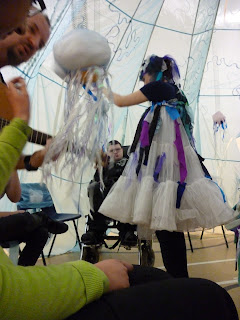I was impressed by the speed of the "get up" - about an hour to assemble Jelly fish, costumes and props.
The session began with a name song in a circle outside of the jellyfish (re-inforcing that notion of airlock between "normal reality" and the magic of the performance space that we had observed with Oily Cart.
The children were then asked who would like to "lead the way in" - which always elicited an enthusiastic volunteer.
The performance began with a simple introductory song "Swimming, swaying under the sea" - the children were encouraged to enjoy the sensory and moving qualities available inside the tent - including marvellous jellyfish attached to slinkies which achieved some great moves and which the children could set swinging themselves.
Jilly the Jellyfish then emerged in a lovely surprise from a camouflage pile of seaweed and introduced herself to each child.
Meanwhile the other performer slipped on an anenome puppet
the puppet had a very playful quality and could interact with children from closer or further, it was curious and able to build a relationship with each individual according to their comfort level and communication styles. It certainly was excellent at engaging. A second anenome puppet appeared from outside the tent and this was again a lovely surprise for those inside the tent.
Then followed the exciting event of the storm - achieved by the high powered air blower, which was directed at each child in turn while the following was sung - The storm blew x away heave away haul away.
The children loved this!!!!!!!!!!!!!!
Following the storm was a blackout prefigured and spoken about and a more contemplative mood while Jellyfish lit by black light danced slowly to each audience member before dancing off.
Then an end song - Jilly the Jellyfish followed by a goodbye song where the children exited being serenaded by name.
Very simple, very effective - a deliberate choice on Bamboozle's part to return to a pared back format for pmld audience. The show lasted just over half and hour.
The performers (including musician Skats) all said that they love this kind of work. Skats mused that he would do it full time if he could - that he found it the most satisfying of all his work. What is it about it that is satisfying - I wanted to hear his answer (because this is also how I feel) - ...
He said perhaps it's because you get to connect with people that are hard to connect with and that you feel you make a difference, that this is most human. He said he can also enjoy playing music at a gig and feeling like you are in the zone, connecting with mainstream audience, but there was something about the other connection (with pmld or SEN children) that felt more satisfying. Perhaps the difference is that the ego is less present in this work I suggested to him - Hmm - yes - perhaps that's it ... it's like you don't need the applause to feel good.

























